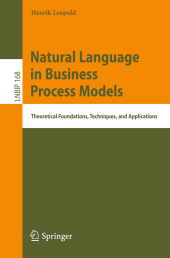 Neuerscheinungen 2013Stand: 2020-01-07 |
Schnellsuche
ISBN/Stichwort/Autor
|
Herderstraße 10
10625 Berlin
Tel.: 030 315 714 16
Fax 030 315 714 14
info@buchspektrum.de |

Henrik Leopold
Natural Language in Business Process Models
Theoretical Foundations, Techniques, and Applications
2013. 2013. xxii, 181 S. 35 SW-Abb. 235 mm
Verlag/Jahr: SPRINGER, BERLIN; SPRINGER INTERNATIONAL PUBLISHING 2013
ISBN: 3-319-04174-6 (3319041746)
Neue ISBN: 978-3-319-04174-2 (9783319041742)
Preis und Lieferzeit: Bitte klicken
Natural language is one of the most important means of human communication. It enables us to express our will, to exchange thoughts and to document our knowledge in written sources. Owing to its substantial role in many facets of human life, technology for automatically analyzing and processing natural language has recently become increasingly important. In fact, natural language processing tools have paved the way for entirely new business opportunities.
The goal of this book is to facilitate the automatic analysis of natural language in process models and to employ this analysis for assisting process model stakeholders. Therefore, a technique is defined that automatically recognizes and annotates process model element labels. In addition, this technique is leveraged to support organizations in effectively utilizing their process models in various ways.
The book is organized into seven chapters. It starts with an overview of business process management and linguistics and continues with conceptual contributions on parsing and annotating process model elements, with the detection and correction of process model guideline violations, with the generation of natural language from process models and finally ends with the derivation of service candidates from process models.
1 Business Process Management.- 2 Linguistics.- 3 Parsing and Annotating Process Model Elements.- 4 Detecting and Correcting Linguistic Guideline Violations.- 5 Generation of Natural Language Texts from Process Models.- 6 Service Derivation from Process Models.- 7 Conclusion.


